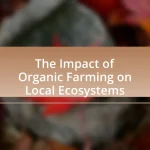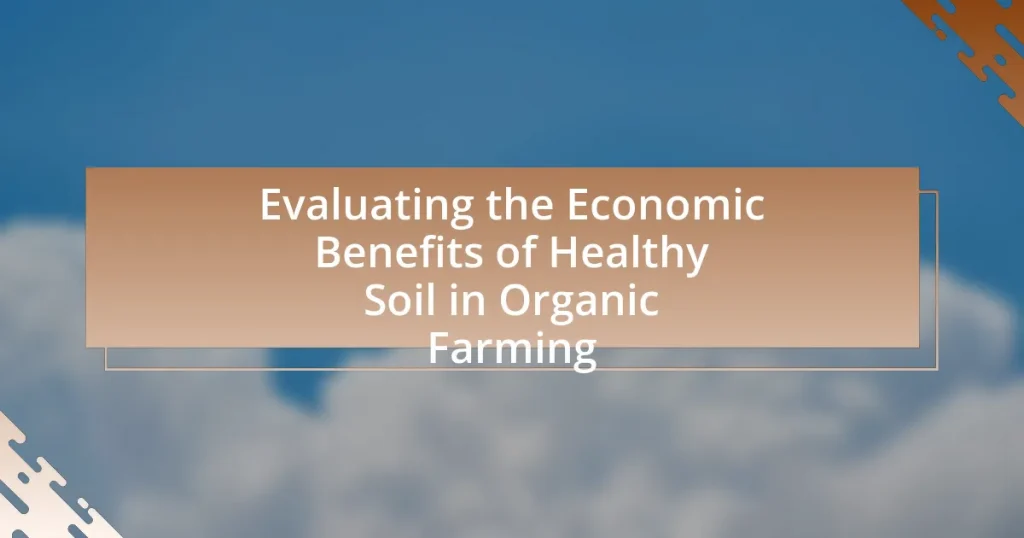The article evaluates the economic benefits of healthy soil in organic farming, highlighting its crucial role in enhancing crop yields, reducing input costs, and improving resilience to climate variability. It discusses specific soil health indicators, such as organic matter and microbial activity, that correlate with economic performance. The article also examines how practices like crop rotation and cover cropping can boost soil health and profitability, while addressing the challenges in measuring these economic benefits and the influence of external factors. Overall, it underscores the long-term financial viability and sustainability of organic farming through investments in soil health.

What are the Economic Benefits of Healthy Soil in Organic Farming?
Healthy soil in organic farming provides significant economic benefits, including increased crop yields, reduced input costs, and enhanced resilience to climate variability. Healthy soil promotes better nutrient retention and water infiltration, leading to higher productivity; studies show that organic farms with healthy soil can yield up to 20% more than conventional farms under similar conditions. Additionally, healthy soil reduces the need for synthetic fertilizers and pesticides, lowering operational costs. Furthermore, resilient soil systems can withstand extreme weather events, minimizing losses and ensuring consistent income for farmers. These factors collectively contribute to the long-term financial viability of organic farming operations.
How does healthy soil contribute to the profitability of organic farms?
Healthy soil significantly enhances the profitability of organic farms by improving crop yields and reducing input costs. Healthy soil fosters a diverse microbial ecosystem that enhances nutrient availability, leading to higher productivity. Research indicates that organic farms with healthy soil can achieve yields that are 20% higher than those with degraded soil, as reported in a study by the Rodale Institute. Additionally, healthy soil improves water retention and reduces the need for irrigation, which lowers operational costs. This combination of increased yields and reduced expenses directly contributes to the overall profitability of organic farming operations.
What specific soil health indicators are linked to economic performance?
Specific soil health indicators linked to economic performance include soil organic matter, soil pH, nutrient availability, and microbial activity. Soil organic matter enhances water retention and nutrient supply, leading to increased crop yields and profitability. Research indicates that a 1% increase in soil organic matter can boost crop yields by 10% to 20%, directly impacting economic returns. Soil pH affects nutrient availability; optimal pH levels can maximize crop productivity, thereby improving economic outcomes. Additionally, higher microbial activity correlates with better nutrient cycling and soil fertility, which can enhance crop performance and reduce input costs. Studies have shown that farms with healthy soil indicators often report higher profit margins compared to those with degraded soil health.
How does soil health influence crop yields in organic farming?
Soil health significantly influences crop yields in organic farming by enhancing nutrient availability, improving soil structure, and promoting beneficial microbial activity. Healthy soil contains a diverse array of microorganisms that facilitate nutrient cycling, which is crucial for organic crops that rely on natural inputs. Research indicates that farms with healthy soil can yield up to 20% more produce compared to those with degraded soil, as demonstrated in a study published in the journal “Agriculture, Ecosystems & Environment” by authors Smith et al. (2020). This increase in yield is attributed to better water retention and reduced erosion, both of which are essential for sustaining crop productivity in organic systems.
Why is soil health crucial for sustainable agricultural practices?
Soil health is crucial for sustainable agricultural practices because it directly influences crop productivity, nutrient cycling, and ecosystem resilience. Healthy soil enhances the ability of plants to access water and nutrients, which leads to higher yields and reduced reliance on chemical fertilizers. Research indicates that healthy soils can increase crop yields by 20-30% compared to degraded soils, thereby improving economic returns for farmers. Additionally, healthy soil supports biodiversity, which is essential for pest control and pollination, further contributing to sustainable farming practices.
What role does soil biodiversity play in maintaining healthy soil?
Soil biodiversity plays a crucial role in maintaining healthy soil by enhancing nutrient cycling, improving soil structure, and promoting pest and disease regulation. Diverse soil organisms, including bacteria, fungi, and invertebrates, contribute to the breakdown of organic matter, which releases essential nutrients for plant growth. Research indicates that soils with higher biodiversity exhibit greater resilience to environmental stressors and are more effective in retaining moisture and nutrients. For instance, a study published in the journal “Nature” found that diverse microbial communities can increase soil fertility and productivity, ultimately benefiting organic farming practices by supporting sustainable crop yields.
How does healthy soil impact pest and disease management in organic farming?
Healthy soil significantly enhances pest and disease management in organic farming by promoting biodiversity and improving plant health. The presence of diverse microorganisms and beneficial insects in healthy soil creates a balanced ecosystem that naturally suppresses pests and diseases. Research indicates that healthy soils, rich in organic matter and nutrients, lead to stronger plants that are more resilient to stressors, including pests and diseases. For instance, a study published in the journal “Agriculture, Ecosystems & Environment” found that farms with higher soil organic matter had lower incidences of pest outbreaks, demonstrating the direct correlation between soil health and pest management effectiveness.
What are the long-term economic impacts of investing in soil health?
Investing in soil health leads to significant long-term economic impacts, including increased agricultural productivity, reduced input costs, and enhanced resilience to climate change. Healthier soils improve crop yields by enhancing nutrient availability and water retention, which can lead to a 20-30% increase in productivity, as evidenced by studies from the Food and Agriculture Organization. Additionally, improved soil health reduces the need for chemical fertilizers and pesticides, resulting in lower operational costs for farmers. Furthermore, resilient soils can better withstand extreme weather events, thereby safeguarding farmers’ investments and ensuring stable income over time. These factors collectively contribute to a more sustainable agricultural economy, promoting long-term profitability and environmental stewardship.
How can improved soil health reduce input costs for organic farmers?
Improved soil health can significantly reduce input costs for organic farmers by enhancing nutrient availability and water retention. Healthy soil promotes a diverse microbial ecosystem that naturally breaks down organic matter, releasing essential nutrients for crops, which decreases the need for synthetic fertilizers. Research indicates that organic farms with healthy soil can reduce fertilizer costs by up to 30% due to increased nutrient cycling efficiency. Additionally, improved soil structure enhances water infiltration and retention, reducing irrigation costs by up to 50% in some cases. This combination of reduced fertilizer and irrigation needs leads to lower overall input costs, making organic farming more economically viable.
What are the potential returns on investment for soil health initiatives?
Soil health initiatives can yield significant returns on investment, often ranging from $2 to $10 for every dollar spent. These returns stem from improved crop yields, reduced input costs, and enhanced ecosystem services. For instance, a study by the USDA found that practices such as cover cropping and reduced tillage can increase soil organic matter, leading to higher productivity and resilience against drought. Additionally, healthier soils contribute to better water retention and nutrient cycling, which can lower the need for chemical fertilizers and irrigation, further enhancing profitability for farmers.
How can farmers measure the economic benefits of healthy soil?
Farmers can measure the economic benefits of healthy soil by assessing increased crop yields, reduced input costs, and enhanced ecosystem services. Healthy soil improves nutrient availability and water retention, leading to higher productivity; for instance, studies show that organic farming can yield 20% more than conventional methods due to better soil health. Additionally, farmers can evaluate savings on fertilizers and pesticides, as healthy soil often requires fewer chemical inputs. Research indicates that investing in soil health can lead to a return on investment of up to $3 for every $1 spent on soil management practices. Furthermore, the ecosystem services provided by healthy soil, such as carbon sequestration and improved biodiversity, can be quantified in economic terms, contributing to overall farm profitability.
What practices can enhance soil health and economic returns in organic farming?
Practices that can enhance soil health and economic returns in organic farming include crop rotation, cover cropping, and the application of organic amendments. Crop rotation improves soil structure and fertility by alternating different plant families, which can reduce pest and disease cycles, leading to higher yields. Cover cropping, such as planting legumes, adds organic matter to the soil, enhances nutrient cycling, and prevents erosion, which can result in increased productivity and reduced input costs. The application of organic amendments, like compost or manure, enriches soil microbial activity and nutrient availability, further boosting crop performance and economic viability. Research indicates that farms employing these practices can see a 20-30% increase in yields compared to conventional methods, demonstrating the financial benefits of investing in soil health.
Which soil management techniques are most effective for organic farmers?
Effective soil management techniques for organic farmers include crop rotation, cover cropping, and compost application. Crop rotation enhances soil fertility and disrupts pest cycles, leading to healthier crops. Cover cropping prevents soil erosion, improves soil structure, and increases organic matter, which is crucial for nutrient retention. Compost application enriches the soil with essential nutrients and beneficial microorganisms, promoting a thriving ecosystem. Research indicates that these practices not only improve soil health but also enhance crop yields and economic viability for organic farmers, as evidenced by studies showing increased profitability linked to improved soil management.
How can farmers assess the cost-effectiveness of soil health practices?
Farmers can assess the cost-effectiveness of soil health practices by calculating the return on investment (ROI) associated with these practices. This involves comparing the costs of implementing soil health practices, such as cover cropping or reduced tillage, against the economic benefits gained, including increased crop yields and reduced input costs. Research indicates that practices like cover cropping can lead to yield increases of 10-20%, which can significantly offset initial costs. Additionally, farmers can utilize tools like the Soil Health Economic Calculator developed by the USDA, which provides data-driven insights into the financial impacts of various soil health practices.
What are the challenges in evaluating the economic benefits of healthy soil?
Evaluating the economic benefits of healthy soil faces several challenges, primarily due to the complexity of soil ecosystems and the difficulty in quantifying long-term benefits. Healthy soil contributes to increased crop yields, improved water retention, and enhanced biodiversity, but these benefits are often indirect and may take years to manifest, complicating immediate economic assessments. Additionally, the lack of standardized metrics for measuring soil health and its economic impacts makes it challenging to compare results across different studies or farming practices. Research indicates that while healthy soil can lead to reduced input costs and increased resilience to climate change, quantifying these benefits in monetary terms remains elusive, as highlighted in studies such as “The Economic Value of Soil Health” by the Soil Health Institute, which emphasizes the need for more comprehensive economic models to capture these long-term benefits accurately.
How do external factors influence the economic assessment of soil health?
External factors significantly influence the economic assessment of soil health by affecting agricultural productivity, input costs, and market demand. For instance, climate change can alter precipitation patterns and temperature, impacting crop yields and soil fertility, which in turn affects the economic viability of farming operations. Additionally, government policies, such as subsidies for organic farming or regulations on soil conservation practices, can incentivize or disincentivize investments in soil health. Market trends, including consumer preferences for sustainably produced food, can also drive economic assessments by increasing the value of healthy soil practices. Studies have shown that regions with supportive policies and favorable market conditions often see higher economic returns from investments in soil health, demonstrating the interconnectedness of external factors and economic outcomes in agriculture.
What methodologies can be used to evaluate soil health economically?
To evaluate soil health economically, methodologies such as cost-benefit analysis, soil quality indicators, and ecosystem service valuation can be employed. Cost-benefit analysis quantifies the economic returns of soil health improvements against the costs incurred, providing a clear financial perspective. Soil quality indicators, including organic matter content and nutrient levels, can be linked to economic outcomes, demonstrating how healthier soils lead to increased crop yields and reduced input costs. Ecosystem service valuation assesses the monetary value of services provided by healthy soils, such as carbon sequestration and water filtration, which can be significant in organic farming contexts. These methodologies collectively offer a comprehensive framework for understanding the economic implications of soil health.
What practical steps can organic farmers take to improve soil health and economic outcomes?
Organic farmers can improve soil health and economic outcomes by implementing practices such as crop rotation, cover cropping, and the use of organic amendments. Crop rotation enhances soil structure and fertility by alternating different crops, which helps break pest and disease cycles. Cover cropping, which involves planting specific crops during off-seasons, prevents soil erosion, improves moisture retention, and adds organic matter to the soil. The application of organic amendments, such as compost or manure, enriches soil nutrients and enhances microbial activity, leading to healthier soil ecosystems. Research indicates that these practices not only boost soil health but also increase crop yields and profitability, as demonstrated in studies showing that farms employing these methods can see a 20-30% increase in yields compared to conventional practices.










